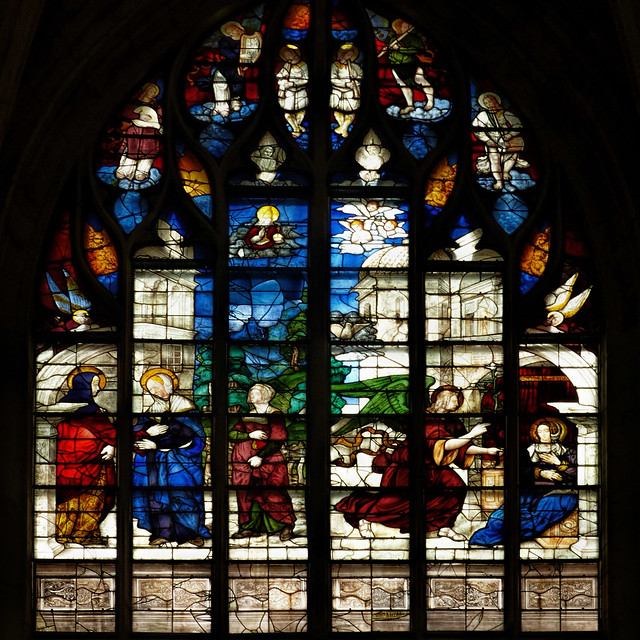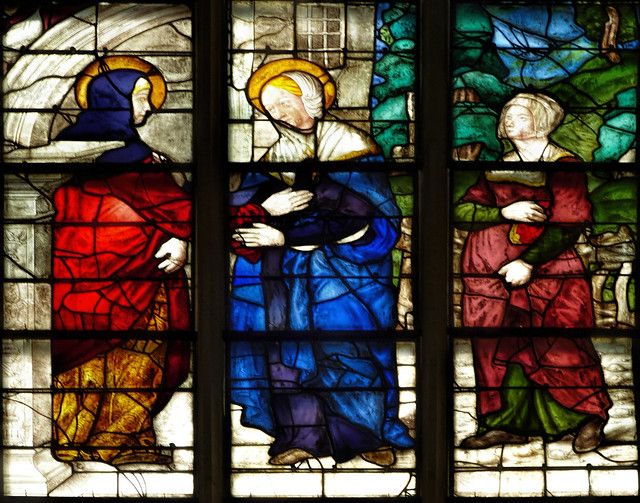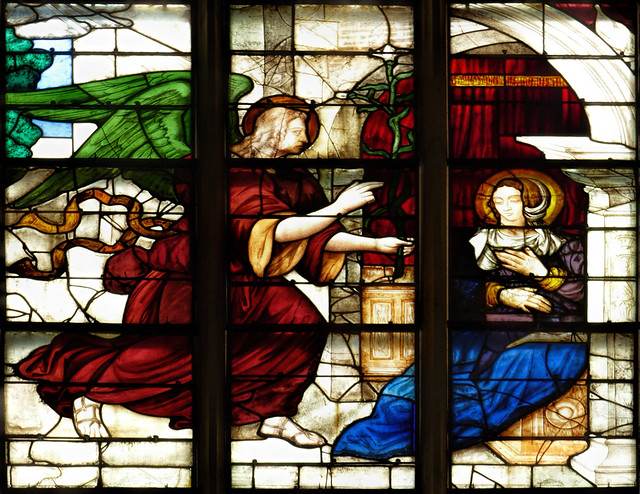The Annunciation and Visitation by Bertin Duval (1531) - Alençon France

'The Annunciation and Visitation' is a stunning Gothic-style stained glass window created by the master glass painter Bertin Duval in 1531. It is located in the Notre-Dame Basilica (Basilique Notre-Dame) in Alençon, Normandy, France, a historic site known for its Renaissance-era stained glass panels. This work exemplifies the transition from medieval to Renaissance aesthetics in French glassmaking, blending intricate narrative scenes from the Life of the Virgin Mary with vibrant colors and symbolic details. The panel measures approximately 5 meters in height and is divided into multiple registers, allowing for the sequential storytelling approach that was typical of 16th-century religious art.
The window is structured in a tall, arched Gothic frame with delicate tracery that divides it into several lancet-like sections, creating a rhythmic flow of vertical panels framed by blue and red borders. The lead lines and stone mullions guide the viewer's eye upward, from earthly scenes to heavenly ones, evoking a sense of divine ascent. The overall palette is rich and jewel-toned: deep blues and reds dominate the figures' garments, accented by golden yellows for halos and divine light, emerald greens for landscapes, and whites for clouds and purity. Light filtering through the glass would cast ethereal glows, enhancing the spiritual atmosphere within the basilica.
The upper portion portrays a celestial realm with a deep blue background and white clouds. At the center, a figure likely representing God, distinguished by a radiant halo and regal posture, presides over the scene. Surrounding this central figure are angels playing instruments. Notably, a figure in green, identified as a flautist, adds a musical element to the heavenly harmony. The arched tracery frames this divine assembly, drawing the eye upward. This sets a prophetic tone, linking Old Testament foreshadowing to New Testament fulfillment, with the stone tracery mimicking architectural arches that ground the divine in the earthly church structure.

The lower panel is divided into two parts, on the left is the Visitation (Luke 1:39–56), where Mary visits her cousin Elizabeth. The scene unfolds in a verdant landscape with rolling green hills and a distant townscape under a serene blue sky.

The scene on the right depicts the Archangel Gabriel's announcement to the Virgin Mary (Luke 1:26–38). On the left, Mary stands in a graceful contrapposto pose, her blue mantle draped over a red gown, hands clasped in modest surprise, a golden halo encircling her veiled head. She is positioned before a simple stone bench or altar, symbolizing her role as the "handmaid of the Lord." Gabriel approaches from the right, dynamic in red and gold robes with large feathered wings, one hand extended in blessing while the other holds a lily (a symbol of purity). A dove representing the Holy Spirit hovers above, emitting golden beams that pierce the scene, illuminating Mary's face and a small vase of flowers at her feet. Flanking this intimate exchange are architectural elements—a white marble column and draped curtain—suggesting an enclosed domestic space, rendered with subtle shading to imply depth. The blue background transitions to a starry firmament, emphasizing the miraculous intrusion of the divine i
Duval's mastery shines in his use of fluxed pot-metal glass, where minerals create opaque, glowing colors without painting—though subtle enamel details add facial expressions and folds. The figures are elongated and elegant, influenced by contemporary Italian Renaissance prints, yet retain the narrative density of Northern Gothic traditions. Symbolism abounds: lilies and doves for purity and incarnation; prophets for continuity; landscapes for the harmony of creation. The window not only educates the illiterate faithful through its vivid typology but also serves as a meditative focal point, inviting contemplation on themes of obedience, joy, and divine favor.
This panel remains a highlight of Alençon's ecclesiastical art, preserved through careful restoration and admired for its luminous storytelling that bridges heaven and earth.
